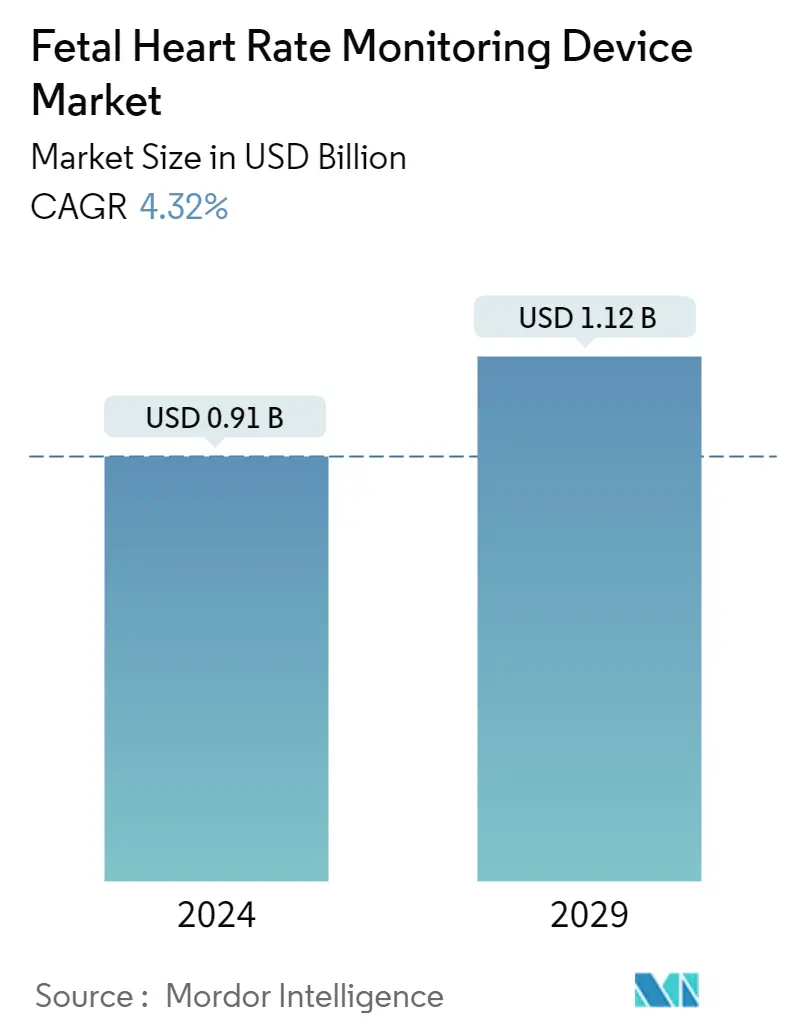Market Size of Fetal Heart Rate Monitoring Device Industry

| Study Period | 2019 - 2029 |
| Market Size (2024) | USD 0.91 Billion |
| Market Size (2029) | USD 1.12 Billion |
| CAGR (2024 - 2029) | 4.32 % |
| Fastest Growing Market | Asia-Pacific |
| Largest Market | North America |
| Market Concentration | Medium |
Major Players
*Disclaimer: Major Players sorted in no particular order |
Fetal Heart Rate Monitoring Devices Market Analysis
The Fetal Heart Rate Monitoring Device Market size is estimated at USD 0.91 billion in 2024, and is expected to reach USD 1.12 billion by 2029, growing at a CAGR of 4.32% during the forecast period (2024-2029).
With the emergence of COVID-19, the focus has shifted more toward patient care and comfort. The study published in July 2021 by PLoS One stated that the elective procedure incidence decreased rapidly at the onset of the first COVID-19 wave in March 2020 but recovered in May and June, after which the surgery incidence was 22% higher than in the reference years. With only urgent surgeries being allowed and most of the cardiac procedures canceled or postponed due to the diversion of resources toward COVID-19-affected patients, the market for fetal heart rate monitoring market was tremendously affected. However, with the rise in demand compelling the situation, regulatory authorities like the United States Food and Drug Administration provided some relaxation in the regulations for the launch of medical devices to provide uninterrupted support and care to the mother and fetus during the challenging situation of the pandemic. Thus, COVID-19 is expected to impact the fetal heart rate monitoring device market positively over the post-pandemic era.
The growth of the market studied is largely attributed to technological advancement in fetal monitoring devices, increasing birth rate and preterm births, and rising government and non-government initiatives to provide better maternal and fetal care. The technological advancement in monitoring devices is likely to drive the market's growth, as it primarily focuses on patient care and comfort. The wireless and in-home monitoring devices introduced in the market enable data sharing with healthcare workers. Preterm birth indicates that a baby is born before the completion of 37 weeks of pregnancy, and lifestyle conditions, such as diabetes and hypertension, are the common causes for this. For instance, as per the article published in July 2020 by the International Journal of Gynecology & Obstetrics, preterm birth is a live birth that occurs before 37 completed weeks of pregnancy, and approximately 15 million babies are born preterm annually worldwide, indicating a global preterm birth rate of about 11%. As per the same source, with 1 million children dying due to preterm birth before the age of 5 years, preterm birth is the leading cause of death among children, accounting for 18% of all deaths among children aged under five years and as many as 35% of all deaths among newborns. Therefore, vigorous heart rate monitoring helps determine the fetus's safety. Hence, owing to the rising number of preterm births and rising usage of these devices in fetal health monitoring, the market is likely to grow with a notable growth rate over the upcoming period.
Various government and non-government agencies also participate to ensure better facilities. For instance, WHO collaborated with ministries of health to strengthen and invest in care, particularly around the time of birth and the first week of life. This is likely to encourage the participation of the organization and boost the market's growth. Due to the aforementioned facts, the fetal heart rate monitoring devices market is expected to witness significant growth over the forecast period.
Various advancements, product approvals, launches, partnerships, and acquisitions by the key market players in cardiac monitoring devices are likely to boost the growth of the market studied over the forecast period. In June 2021, Nuvo Group-a private company commercializing INVU by Nuvo, an FDA-cleared, patent-protected, prescription-initiated remote pregnancy monitoring platform, announced that it had received clearance from the US Food and Drug Administration (FDA) to add a new uterine activity module that provides the capability for remote monitoring of uterine activity (UA). Such product launches are anticipated to result in the growth of the market.
However, stringent regulatory norms for medical devices and the high cost associated with fetal heart rate monitoring devices may act as restraining factors for the market studied.
Fetal Heart Rate Monitoring Devices Industry Segmentation
As per the scope of the report, fetal heart rate monitoring refers to the process of measuring the heart rate and rhythm of the fetus during late pregnancy and labor to monitor and check the condition of the fetus with special equipment. The monitoring helps healthcare professionals to identify any risk factors earlier and reassure normal conditions.
The fetal heart rate monitoring device market is segmented by product type (internal fetal heart rate monitoring device and external fetal heart rate monitoring device), technology type (Doppler ultrasound device and electronic fetal monitoring device), portability of device (portable and non-portable), and geography (North America, Europe, Asia-Pacific, and Rest of the World). The market report also covers the estimated market sizes and trends for 17 different countries across major regions globally. The report offers the value (in USD million) for the aforementioned segments.
| By Product Type | |
| Internal Fetal Heart Rate Monitoring Device | |
| External Fetal Heart Rate Monitoring Device |
| By Technology Type | |
| Doppler Ultrasound Device | |
| Electronic Fetal Monitoring Device |
| By Portablity of Device | |
| Portable | |
| Non-portable |
| By Geography | ||||||||
| ||||||||
| ||||||||
| ||||||||
| Rest of the World |
Fetal Heart Rate Monitoring Device Market Size Summary
The fetal heart rate monitoring devices market is poised for growth, driven by technological advancements and increasing birth rates, including preterm births. The market's expansion is supported by both government and non-government initiatives aimed at enhancing maternal and fetal care. The introduction of wireless and in-home monitoring devices has revolutionized patient care, allowing for real-time data sharing with healthcare professionals. This technological progress is particularly significant in the context of rising preterm birth rates, which necessitate rigorous fetal monitoring to ensure safety. The COVID-19 pandemic, while initially disruptive, has led to regulatory relaxations that have further stimulated market growth by facilitating the launch of essential medical devices.
North America is expected to dominate the fetal heart rate monitoring devices market due to its advanced healthcare infrastructure and substantial investment in research and development. The region's well-established healthcare systems and favorable reimbursement policies contribute to its leading position. The market is characterized by moderate competition, with major players like GE Healthcare, Siemens Healthineers, and Fujifilm Holdings Corporation holding significant market shares. These companies, along with others, are actively involved in product innovations and strategic partnerships to enhance their market presence. Despite challenges such as stringent regulatory norms and high device costs, the market is anticipated to witness significant growth, driven by ongoing technological advancements and increasing awareness of fetal health monitoring.
Fetal Heart Rate Monitoring Device Market Size - Table of Contents
-
1. MARKET DYNAMICS
-
1.1 Market Overview
-
1.2 Market Drivers
-
1.2.1 Technological Advancement in Fetal Monitoring Devices
-
1.2.2 Rising Number of Birth Rate and Preterm Births
-
1.2.3 Rising Government and Non-government Initiatives to Provide Better Maternal and Fetal Care
-
-
1.3 Market Restraints
-
1.3.1 Strigent Regulatory Norms for Medical Devices
-
1.3.2 High Cost Associated with Fetal Heart Rate Monitoring Devices
-
-
1.4 Industry Attractiveness - Porter's Five Forces Analysis
-
1.4.1 Bargaining Power of Buyers/Consumers
-
1.4.2 Bargaining Power of Suppliers
-
1.4.3 Threat of New Entrants
-
1.4.4 Threat of Substitute Products
-
1.4.5 Intensity of Competitive Rivalry
-
-
-
2. MARKET SEGMENTATION (Market Size by Value - USD million)
-
2.1 By Product Type
-
2.1.1 Internal Fetal Heart Rate Monitoring Device
-
2.1.2 External Fetal Heart Rate Monitoring Device
-
-
2.2 By Technology Type
-
2.2.1 Doppler Ultrasound Device
-
2.2.2 Electronic Fetal Monitoring Device
-
-
2.3 By Portablity of Device
-
2.3.1 Portable
-
2.3.2 Non-portable
-
-
2.4 By Geography
-
2.4.1 North America
-
2.4.1.1 United States
-
2.4.1.2 Canada
-
2.4.1.3 Mexico
-
-
2.4.2 Europe
-
2.4.2.1 Germany
-
2.4.2.2 United Kingdom
-
2.4.2.3 France
-
2.4.2.4 Italy
-
2.4.2.5 Spain
-
2.4.2.6 Rest of Europe
-
-
2.4.3 Asia-Pacific
-
2.4.3.1 China
-
2.4.3.2 Japan
-
2.4.3.3 India
-
2.4.3.4 Australia
-
2.4.3.5 South Korea
-
2.4.3.6 Rest of Asia-Pacific
-
-
2.4.4 Rest of the World
-
-
Fetal Heart Rate Monitoring Device Market Size FAQs
How big is the Fetal Heart Rate Monitoring Device Market?
The Fetal Heart Rate Monitoring Device Market size is expected to reach USD 0.91 billion in 2024 and grow at a CAGR of 4.32% to reach USD 1.12 billion by 2029.
What is the current Fetal Heart Rate Monitoring Device Market size?
In 2024, the Fetal Heart Rate Monitoring Device Market size is expected to reach USD 0.91 billion.

